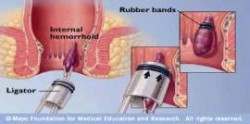Cryotherapy for Hemorrhoids Treatment
 Overview: Non-Surgical Hemorrhoid Treatments
Overview: Non-Surgical Hemorrhoid Treatments
There are a variety of non-surgical hemorrhoids treatments currently in use, and all have similar benefits when it comes to providing relief from the symptoms of hemorrhoids. Non-surgical techniques are less invasive than surgery for hemroids, and as such have shorter and fewer painful recovery periods.
Some of the more popular non-surgical treatments for hemorrhoids include rubber band ligation, sclerotherapy, electric current treatment and heat coagulation. Another form of non-surgical hemroids treatment that has been gaining in popularity is cryotherapy.
Simply put, cryotherapy is the application of extreme cold to destroy diseased or abnormal tissue. It decreases cellular metabolism in the affected area and kills the cells by crystallizing the cytosol, or intracellular fluid. Additionally, cryotherapy can reduce pain and spasm in the area to which it is applied.
Cryotherapy is commonly used for minor muscle injuries in the form of ice packs, which are applied to the affected muscles. Additionally, cryogenic chamber therapy is also used by many athletes and sporting bodies to treat and rehabilitate injuries. Cryotherapy may also be used to treat conditions such as skin disorders, including solar keratoses, skin tags, warts and moles.
Cryotherapy for Hemorrhoids Treatment
When used as a hemorrhoids treatment, cryotherapy works as a vasoconstrictor, meaning it helps shrink the blood vessels of hemroids, providing instant relief from the discomfort that accompanies the condition. In addition to working on the veins in the hemorrhoidal tissue, cryotherapy reduces the swelling in the nerves in the area, thus reducing pain and discomfort. Cryotherapy as a treatment for hemroids is very effective, with little or no side effects.
The downside of cryotherapy is that some post-procedure pain may be experienced, however, it is still much less than what would follow surgery for hemroids. Furthermore, cryotherapy still carries a risk of reoccurrence of hemroids following the procedure, and you may find yourself having to undergo repeat treatments.
Liquid nitrogen is commonly used as a freezing agent in cryotherapy when the procedure is administered by a physician. There are also cryotherapy products which can be self-administered for hemorrhoids treatment at home. In general, the way these home treatment products work is the cryotherapy device is put into the freezer until it reaches a certain temperature and is cold enough. A cream is then applied to the portion of the device which will be inserted into the rectum. Finally, the device is inserted into the rectum for about 6 to 8 minutes, after which time it will usually return to body temperature. The procedure must then be repeated at least 4 times a day to be effective.
Many hemorrhoids sufferers try at-home cryotherapy to treat their hemroids because the procedure is relatively easy to administer, and can be done in the privacy of your own home. Furthermore, it is a very affordable treatment method, usually running less than $50 a treatment pack.
At-home cryotherapy treatments have proven effective on hemorrhoids, especially in those cases where the hemroids are not very severe. For more extreme cases, however, it is best to seek a doctor’s advice and possibly pursue professionally administered cryotherapy treatment for your hemorrhoids.